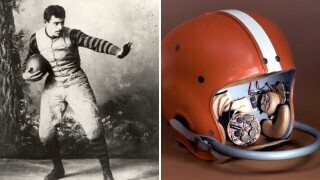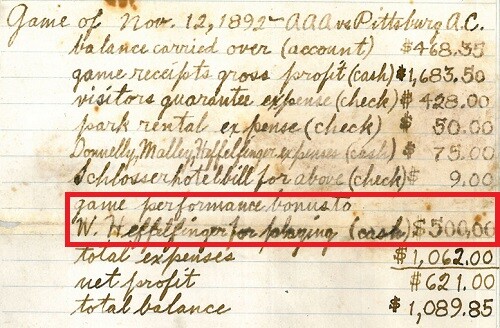4 Ways Football Was Even More Nuts Than Now

Football used to be played by putting an inflated pig bladder in the middle of 50 rowdy villagers and waiting until one of them pushed it through a goalpost, or someone got trampled to death; whatever happened first. Today, it's at least two times safer. While the spirit of the game ("hurt other people") remains intact, a lot has changed since that time, like the fact that ...
"Mob Football" Matches Left Players Broken (Or Worse)
Early football matches didn't inspire riots: they were riots. When football reached America, it was still in its raw "mob football" form, which consisted of mobs of unlimited numbers of people chasing a ball through a large patch of land until they managed to push it through a designated goal post, which could be anything from some sticks on the ground to someone's balcony. There were only a handful of rules, like "don't carry the ball in a bag or vehicle," "no playing on sacred ground," or, oh yeah, "don't murder anyone." They didn't say anything about not breaking a few of their bones, though.
Don't Miss
In England, some games were played across an entire town or even towns, causing the locals to board up their windows in anticipation of this tornado of human flesh. If you're wondering what that looked like, you'll be glad to learn it's still played annually in at least one British town:
Mob football was played in American universities since at least the 1820s. For decades, Harvard had a tradition known as "Bloody Monday," in which masses of sophomores would use the flimsy pretense of pushing a ball through a goalpost as an excuse to plow the hell out of freshmen on the first Monday of each academic year. In 1860, Harvard authorities finally got bored of seeing the little geniuses crippling each other before classes even started and banned the Bloody Monday football game. Students simply took out the "football" part and turned it into a clandestine nighttime event that involved no ball, only fighting.
Other universities had better luck taming the games by turning them into official activities and sending their teams to compete against each other -- that way, they could set some rules and make sure the hostility was directed towards the other university's students, not their own. Things could still get pretty brutal, though: the 1894 Harvard-Yale game is known as the "Hampden Park Bloodbath" because it resulted in smashed heads, broken legs, jabbed, bloody eyes, and one player ending up in an hours-long coma. At least 45 football players were killed between 1900 and 1905, forcing Teddy Roosevelt to step in and go, "Whoa, whoa, tone it down, guys."

In the meantime, the game had started incorporating some rugby elements and its own wacky rules, and American football was taking shape. Of course, there are still considerable differences to the sport as we know it today, such as the fact that ...
Until The '70s, Even Pro Players Had "Real" Jobs On The Side
By the 1890s, football had spread outside of colleges, and athletic clubs had begun popping up all over America, largely made out of sandlot workers looking to blow off some steam. At the time, clubs were supposed to be strictly amateur, and paying the players was considered unsportsmanlike -- but as the rivalries between the teams intensified, the owners found ways to lure in valuable players anyway, like giving them needlessly fancy "prizes" they could pawn or doubling their "expense money." Or, in the case of railroad worker William "Pudge" Heffelfinger, just paying him $500 (around $16,000 today) as a "game performance bonus" for a single game. That sneaky, dishonorable payment is why Heffelfinger is now considered the first professional football player in America.

Within the next decade, the clubs would abandon the pretense of playing "just for funsies," and the game was professionalized -- but that didn't mean players could live from it. Jay Berwanger, the top pick in the first NFL draft in 1936, turned down $125-$150 per game and decided it would be more profitable to become a foam rubber salesman. Player turned coach John Heisman (of "Heisman Trophy" fame) made his living as a Shakespearean actor, and if anyone doubted that, all they had to do was listen to his pep talks. Instead of shouting, "Go git 'em, boys!" he'd pick up a football and ponder:
"What is this? It is a prolate spheroid, an elongated sphere in which the outer leather casing is drawn tightly over a somewhat smaller rubber tubing. Better to have died as a small boy than to fumble this football."

Even by the 1960s, pro players still had to get jobs like math teacher, insurance salesman, or dairy farmer to make ends meet during the off-season. Today, players keep in shape during those months through intense conditioning programs; back in the '50s, Browns running back Maurice Bassett did it by walking five miles a day to deliver mail.
By now, the NFL starts looking after talent when they're in the Pee Wee leagues, and they can go their entire lives working no other job than "football player" (and maybe "Hollywood actor" or "guy famous for totally not killing his wife"). This only became possible after the '70s and '80s, when TV networks noticed people liked watching football at home and began showering players with money. It was also in the '70s that companies realized the half-hour break in the middle of the Super Bowl was the perfect opportunity to expose people to their best and/or dumbest ads.
Now, the first Super Bowl may not have had Snoop Dogg or Emimem, but it did have ...
Players Smoking During Games Was No Big Deal
It's one thing to know that football players used to smoke all the time because everyone used to smoke all the time. It's quite another to actually see the legendary Kansas City Chiefs QB Len Dawson enjoying a cigarette (and a Fresca) during half-time at the first Super Bowl in 1967:
According to players of the era, this was not an uncommon sight. Hall of Famer Fred Arbanas says he personally favored cigars, and so many of his teammates smoked that "you'd come into our locker room and you could hardly see, it'd be so smoky in there." The Chief's stadium even came equipped with ashtrays in all locker room stalls. Smoking and football already had a long association by then since the first ever football cards came packed with cigarettes, not bubble gum. Collect 'em all, kids!

Half a century later, here's Pittsburg Steelers QB Bobby Layne sharing the secret to his success: Marlboro cigs.
And here's the Dallas Cowboys' Bob Lilly whipping out his big cigar after winning the Super Bowl in 1972:
Of course, it was also common to see coaches going through entire packs on the sidelines. The same thing happened in English association football, where managers were encouraged to take up smoking to assert their authority over players because nothing says "respect me" like absolutely foul breath.
Smoking in football only decreased in the '70s, when people became more aware of the fact that the main medical consequence of puffing a cigarette isn't "cooling your throat." Locker room smoking had been squashed by the late '80s, so kudos to the NFL for taking less than a century to squash that particular danger to their players' health. Now do CTE.
Hey, speaking of which ...
The First Helmet Radio Was Used In Secret (And Backfired)
The football helmet has changed a lot since the day one player decided to wrap some leather around his head because his doctor told him he risked death or "instant insanity" if he got kicked there even once more. Before then, players would simply leave their hair long to put a little bit of padding between the other guy's foot and their skulls. Helmets only became mandatory in the NFL in 1943, and it could be argued that the next innovation in their history came 13 years later, when two Cleveland Browns fans realized they could be used for something more important than safety: hi-tech cheating.
See, the fans figured out how to jam a radio inside a helmet with the idea that it would help the coaches communicate more easily with QBs and give their team an advantage. They offered their invention to the Browns' owner, who liked the idea and told them to keep it secret. The Browns used it during a match against the Detroit Lions, who figured out what was going on after their spy on the enemy sidelines saw the hidden radio transmitter.
After that, every team wanted a radio helmet -- or, alternatively, a way to jam them. Before a game against the New York Giants, the Browns' owner warned them that signal jammers were against FCC regulations. So, the Giants didn't interrupt the Browns' signal ... they simply sat a backup player down next to a radio set and had him listen in on it. The Giants won that game 21-9.
Days later, the NFL commissioner banned radio helmets saying the only thing a QB should have inside his helmet is his own brains. They would remain banned until the '90s, when the NFL realized they would be a good way to make the game faster and more TV-friendly -- besides since when do they care about players' brains?
Follow Maxwell Yezpitelok's heroic effort to read and comment on every '90s Superman comic at Superman86to99.tumblr.com.
Thumbnail: Oberlin College Archives/Wikimedia Commons, Pro Football Hall of Fame